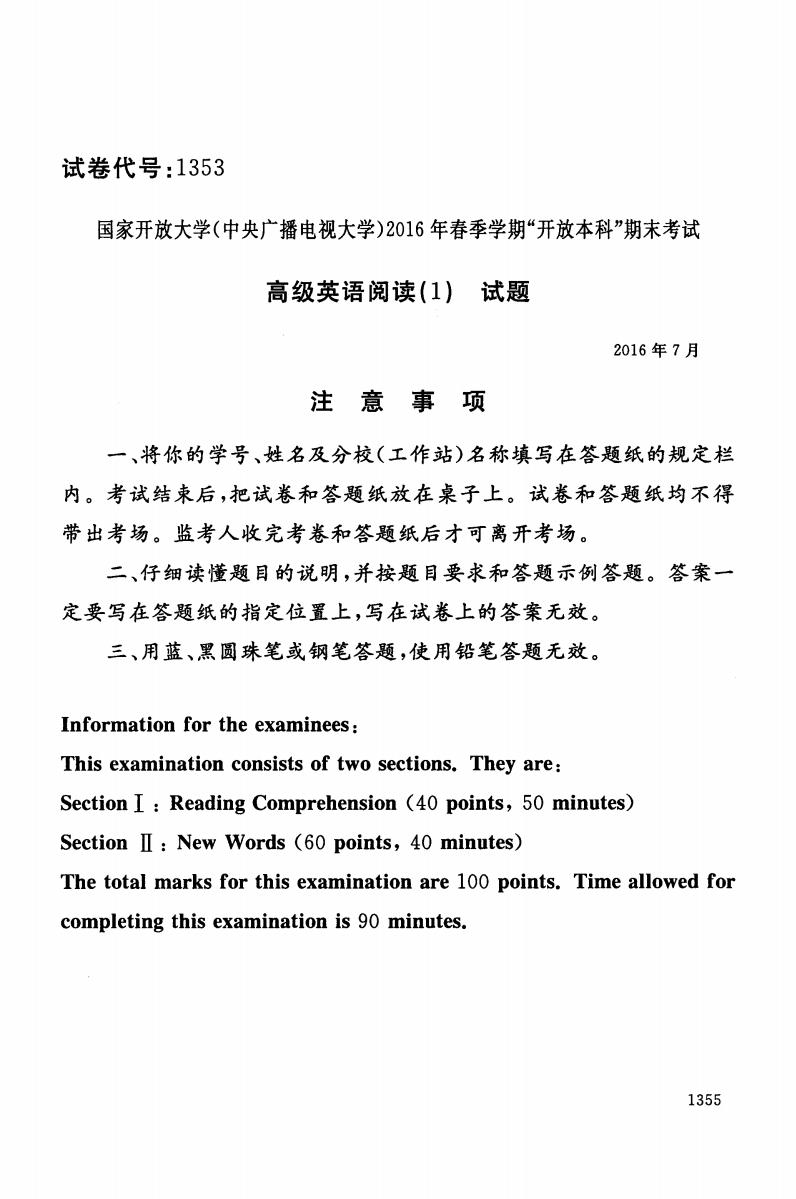
试卷代号:1353 国家开放大学(中央广播电视大学)2016年春季学期“开放本科”期末考试 高级英语阅读(1)试题 2016年7月 注意事项 一、将你的学号、姓名及分校(工作站)名称填写在答题纸的规定栏 内。考试结束后,把试卷和答题纸放在桌子上。试卷和答题纸均不得 带出考场。监考人收完考卷和答题纸后才可离开考场。 二、仔细读懂题目的说明,并按题目要求和答题示例答题。答案一 定要写在答题纸的指定位置上,写在试卷上的答案无效。 三、用蓝、黑圆珠笔或钢笔答题,使用铅笔答题无效。 Information for the examinees: This examination consists of two sections.They are: Section I:Reading Comprehension (40 points,50 minutes) SectionⅡ:New Words(60 points,40 minutes)) The total marks for this examination are 100 points.Time allowed for completing this examination is 90 minutes. 1355
试卷代号 :1353 国家开放大学(中央广播电视大学)2016 年春季学期"开放本科"期末考试 高级英语阅读( 1 ) 试题 2016 注意事项 一、将你的学号、姓名及分校(工作站)名称填写在答题纸的规定栏 内。考试结束后,把试卷和答题纸放在桌子上。试卷和答题纸均不得 带出考场。监考人收完考卷和答题纸后才可离开考场。 二、仔细读懂题目的说明,并按题目要求和答题示例答题。答案一 定要写在答题纸的指定位置上,写在试卷上的答案无效。 三、用蓝、黑圆珠笔或钢笔答题,使用铅笔答题无效。 Information for the examinees: This examination consists of two sections. They are: Section 1 : Reading Comprehension (40 points, 50 minutes) Section II : New Words (60 points, 40 minutes) The total marks for this examination are 100 points. Time allowed for completing this examination is 90 minutes. 1355

Section I Reading Comprehension(40 points) 囚 Read the passage.Then answer the questions that follow.(5 points each) A Even though education is compulsory for children in the United States.it is not compulsory for them to go to a conventional school to get that education.In every one of the 50 states,it is legal for parents to educate their children at home,or to"home school"their children.Although no state requires parents to have special training to home school their children,the regulations parents must follow vary widely from state to state.New Jersey,for example,imposes virtually no requirements.In contrast,New York requires home schoolers to notify their school districts,file instructional plans and frequent reports,and submit the results of tests or other forms of assessment for each child. B Increasing numbers of American families have been opting for home schooling. According to the National Center for Educational Statistics,about 1.1 million children were being home schooled in the spring of 2003.This represents an increase from the 850,000 who were being home schooled in the spring of 1999.In addition,the home-schooling rate-the percentage of the school-age population that was being home schooled-increased from 1.7 percent in 1999 to 2.2 percent in 2003. A survey conducted in 2003 asked parents to give their most important reasons for home schooling their children.Thirty-one percent cited concerns about the environment in conventional schools,including safety,drugs,or negative peer pressure.Thirty percent said that the most important reason was to provide religious or moral instruction.Sixteen percent said that the most important reason was dissatisfaction with academic instruction at conventional schools.Parents gave other reasons,too;for instance,many said that they wanted to strengthen family bonds or allow their children more freedom. 1356
Section 1 Reading Comprehension (40 points) Read the passage. Then answer the questions that follow. (5 points each) A Even though education is compulsory for children in the United States. it is not compulsory for them to go to a conventional school to get that education. In every one of the 50 states,it is legal for parents to educate their children at home , or to"home school"their chilaren. Although no state requires parents to have special training to home school their children , the regulations parents must follow vary widely from state to state. New J ersey , for example ,imposes virtually no requirements. In contrast ,New York requires home schoolers to notify their school districts, file instructional plans and frequent reports, and submit the results of tests or other forms of assessment for each child. B Increasing numbers of American families have been opting for home schooling. According to the National Center for Educational Statistics, about 1. 1 million children were being home schooled in the spring of 2003. This represents an increase from the 850 ,000 who were being home schooled in the spring of 1999. In addition , the home-schooling rate-the percentage of the school-age population that was being home schooled increased from 1. 7 percent in 1999 to 2.2 percent in 2003. C A survey conducted in 2003 asked parents to give their most important reasons for home schooling their children. Thirty-one percent cited concerns about the environment in conventional schools, incIuding safety , drugs, or negative peer pressure. Thirty percent said that the most important reason was to provide religious or moral instruction. Sixteen percent said that the most important reason was dissatisfaction with academic instruction at conventional schools. Parents gave other reasons, too; for instance , many said that they wanted to strengthen family bonds or allow their children more freedom. 1356
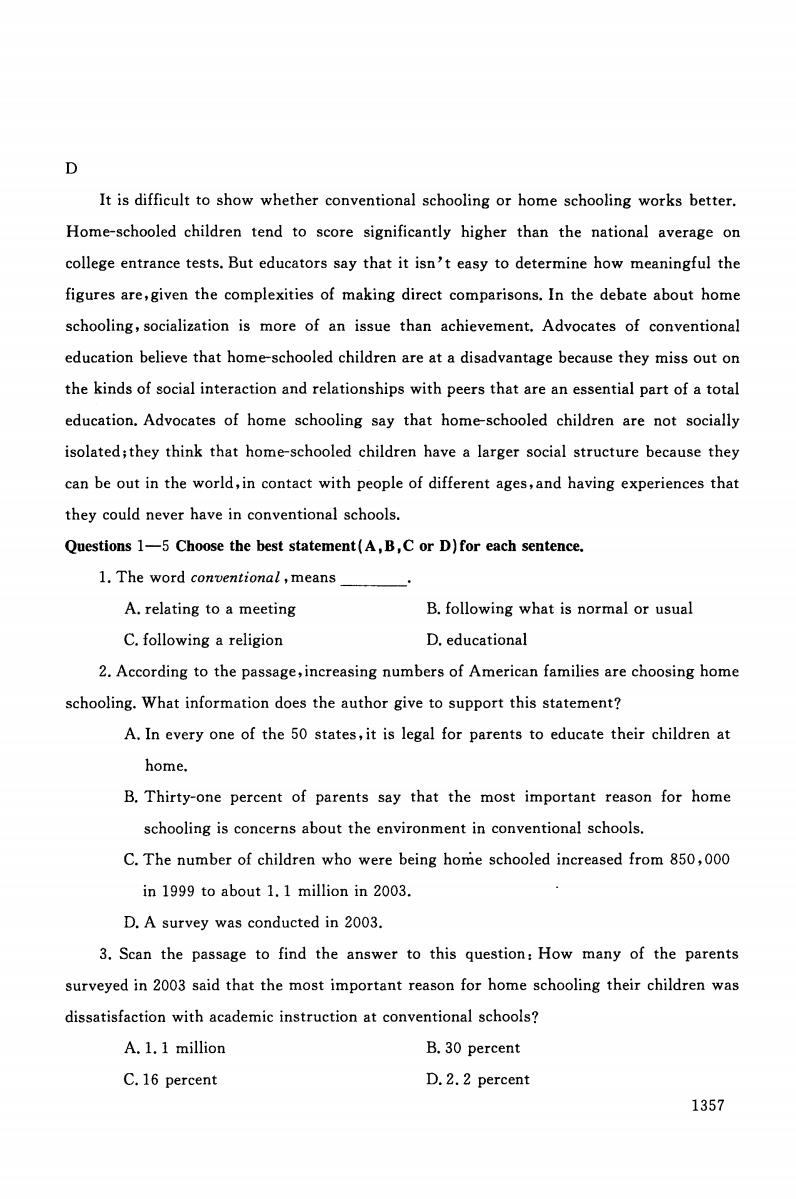
D It is difficult to show whether conventional schooling or home schooling works better. Home-schooled children tend to score significantly higher than the national average on college entrance tests.But educators say that it isn't easy to determine how meaningful the figures are,given the complexities of making direct comparisons.In the debate about home schooling,socialization is more of an issue than achievement.Advocates of conventional education believe that home-schooled children are at a disadvantage because they miss out on the kinds of social interaction and relationships with peers that are an essential part of a total education.Advocates of home schooling say that home-schooled children are not socially isolated;they think that home-schooled children have a larger social structure because they can be out in the world,in contact with people of different ages,and having experiences that they could never have in conventional schools. Questions 1-5 Choose the best statement(A,B,C or D)for each sentence. 1.The word conventional,means A.relating to a meeting B.following what is normal or usual C.following a religion D.educational 2.According to the passage,increasing numbers of American families are choosing home schooling.What information does the author give to support this statement? A.In every one of the 50 states,it is legal for parents to educate their children at home. B.Thirty-one percent of parents say that the most important reason for home schooling is concerns about the environment in conventional schools. C.The number of children who were being home schooled increased from 850,000 in 1999 to about 1.1 million in 2003. D.A survey was conducted in 2003. 3.Scan the passage to find the answer to this question:How many of the parents surveyed in 2003 said that the most important reason for home schooling their children was dissatisfaction with academic instruction at conventional schools? A.1.1 million B.30 percent C.16 percent D.2.2 percent 1357
D It is difficult to show whether conventional schooling or home schooling works better. Home-schooled children tend to score significantly higher than the national average on college entrance tests. But educators say that it isn' t easy to determine how meaningful the figures are ,given the complexities of making direct comparisons. In the debate about home schooling , socialization is more of an issue than achievement. Advocates of conventional education believe that home-schooled children are at a disadvantage because they miss out on the kinds of social interaction and relationships with peers that are an essential part of a total education. Advocates of home schooling say that home-schooled children are not socially isolated; they think that home-schooled children have a larger social structure because they can be out in the world , in contact with people of different ages, and having experiences that they could never have in conventional schools. Questions 1-5 Choose the best statement B I C or D) for each sentence. 1. The word conventional , means A. relating to a meeting c. following a religion B. following what is normal or usual D. educational 2. According to the passage ,increasing numbers of American families are choosing home schooling. What information does the author give to support this statement? A. In every one of the 50 states, it is legal for parents to educate their children at home. B. Thirty-one percent of parents say that the most important reason for home schooling is concerns about the environment in conventional schools. C. The number of children who were being home schooled increased from 850 ,000 in 1999 to about 1. 1 million in 2003. D. A survey was conducted in 2003. 3. Scan the passage to find the answer to this question: How many of the parents surveyed in 2003 said that the most important reason for home schooling their children was dissatisfaction with academic instruction at conventional schools? A. 1. 1 million C. 16 percent B. 30 percent D. 2. 2 percent 1357
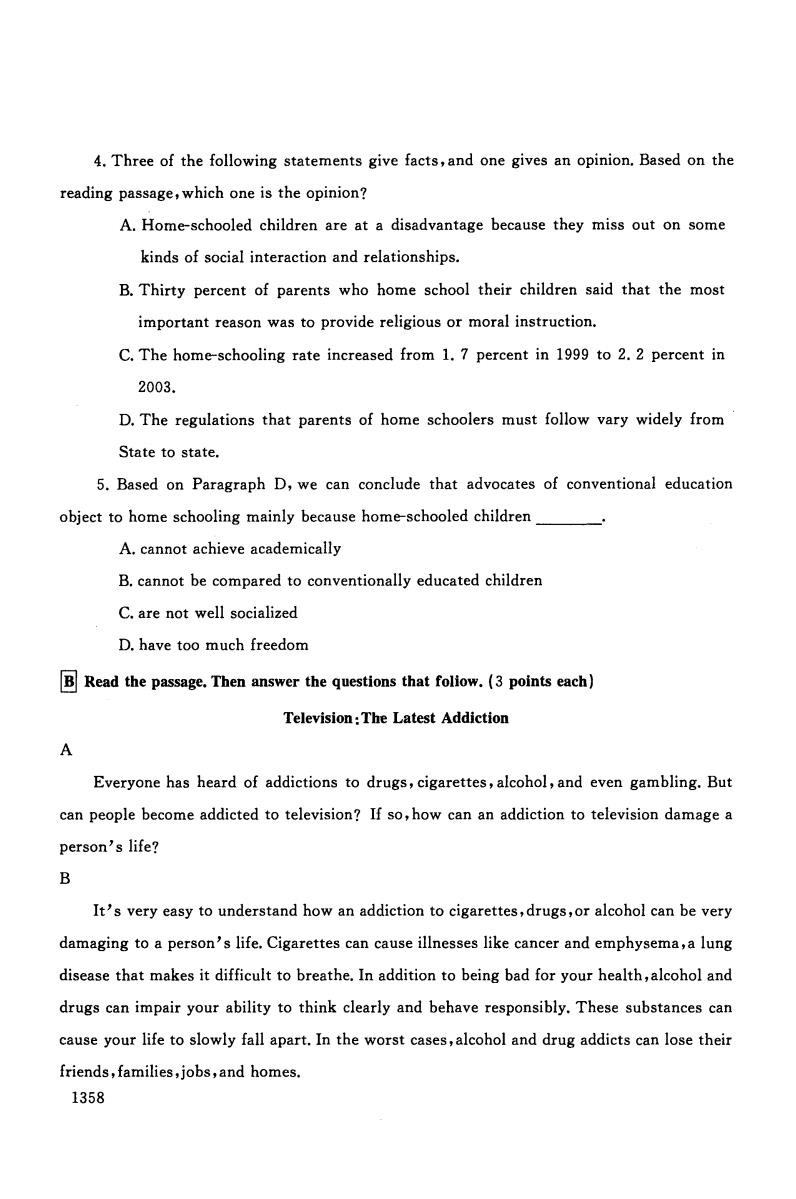
4.Three of the following statements give facts,and one gives an opinion.Based on the reading passage,which one is the opinion? A.Home-schooled children are at a disadvantage because they miss out on some kinds of social interaction and relationships. B.Thirty percent of parents who home school their children said that the most important reason was to provide religious or moral instruction. C.The home-schooling rate increased from 1.7 percent in 1999 to 2.2 percent in 2003. D.The regulations that parents of home schoolers must follow vary widely from State to state. 5.Based on Paragraph D,we can conclude that advocates of conventional education object to home schooling mainly because home-schooled children A.cannot achieve academically B.cannot be compared to conventionally educated children C.are not well socialized D.have too much freedom B Read the passage.Then answer the questions that foliow.(3 points each) Television:The Latest Addiction A Everyone has heard of addictions to drugs,cigarettes,alcohol,and even gambling.But can people become addicted to television?If so,how can an addiction to television damage a person's life? B It's very easy to understand how an addiction to cigarettes,drugs,or alcohol can be very damaging to a person's life.Cigarettes can cause illnesses like cancer and emphysema,a lung disease that makes it difficult to breathe.In addition to being bad for your health,alcohol and drugs can impair your ability to think clearly and behave responsibly.These substances can cause your life to slowly fall apart.In the worst cases,alcohol and drug addicts can lose their friends,families,jobs,and homes. 1358
4. Three of the following statements give facts, and one gives an opinion. Based on the reading passage , w hich one is the opinion? A. Home-schooled children are at a disadvantage because they miss out on some kinds of social interaction and relationships. B. Thirty percent of parents who home school their children said that the most important reason was to provide religious or moral instruction. C. The home-schooling rate increased from 1. 7 percent in 1999 to 2. 2 percent in 2003. D. The regulations that parents of home schoolers must follow vary widely from State to state. 5. Based on Paragraph D, we can conclude that advocates of conventional education object to home schooling mainly because home-schooled children 一一一一一· A. cannot achieve academically B. cannot be compared to conventionally educated children C. are not well socialized D. have too much freedom Read passage. Then answer the questions that foliow. (3 points each) Television : The Latest Addiction A Everyone has heard of addictions to drugs, cigarettes, alcohol , and even gambling. But can people become addicted to television? If so , how can an addiction to television damage a person' s life? B It' s very easy to understand how an addiction to cigarettes, drugs, or alcohol can be very damaging to a person's life. Cigarettes can cause illnesses like cancer and emphysema ,a lung disease that makes it difficult to breathe. In addition to being bad for your health ,alcohol and drugs can impair your ability to think clearly and behave responsibly. These substances can cause your life to slow ly fall apart. In the worst cases, alcohol and drug addicts can lose their friends , families ,jobs, and homes. 1358

But how can watching too much television be harmful to your life and health?One way is that it can start a cycle of bad feelings.According to one study,people who watch the most TV already suffer from anxiety or loneliness.Watching TV makes them feel relaxed and helps them forget about their feelings for a while.But the study found that while people did relax while watching television,the feelings of relaxation disappeared after they stopped watching,and the people felt worse than they did when they started watching TV. Therefore,they wanted to watch more television so they could continue to forget their bad feelings.All this TV watching kept them from doing things that could actually make them feel better,like exercising,participating in hobbies,reading,or spending time with friends and family. D Another way TV watching can be harmful is,like the addictions mentioned above,TV can cause you to neglect your life.The more you watch,the more you want to watch,and after a while,TV replaces real experiences.TV addicts stop talking to their families,don't exercise,don't see their friends,and don't learn new things.Basically,TV addicts stop experiencing life. E The harmful effects of TV addiction may not be as obvious as those of cigarette,drug,or alcohol addiction,but TV addiction can take a person's life away.If you think that excessive TV watching is not harmful,keep track of how much TV you watch every day,and think about all the other things you could be doing during those wasted hours. Decide whether the following statements are true or false.Write"T"for True and"F"for False on the Answer Sheet. 6.People watch a lot of TV,but there is no such thing as a TV addiction. 7.According to the article,one way cigarette smoking can be harmful to your life is that it can cause serious health problems. 8.Drugs and alcohol keep addicts from thinking clearly and being responsible. 9.According to a study,the people who watch the most TV already feel bad about themselves and their lives. 10.Television addicts probably are not healthy and physically fit. 1359
C But how can watching too much te1evision be harmfu1 to your 1ife and health? One way is that it can start a cycle of bad fee1ings. According to one study,peop1e who watch the most TV a1ready suffer from anxiety or 10neliness. Watching TV makes them fee1 re1axed and he1ps them forget about their feelings for a while. But the study found that while peop1e did re1ax while watching te1evision , the feelings of re1axation disappeared after they stopped watching , and the peop1e felt worse than they did when they started watching TV. Therefore , they wanted to watch more te1evision so they cou1d continue to forget their bad feelings. All this TV watching kept them from doing things that cou1d actually make them fee1 better, like exercising , participating in hobbies, reading , or spending time with friends and family. D Another way TV watching can be harmfu1 is, like the addictions mentioned above , TV can cause you to neg1ect your life. The more you watch , the more you want to watch , and after a while , TV rep1aces rea1 experiences. TV addicts stop ta1king to their families, don' t exercise , don 't see their friends , and don' t 1earn new things. Basically , TV addicts stop experiencing 1ife. E The harmfu1 effects of TV addiction may not be as obvious as those of cigarette , drug , or a1coho1 addiction , but TV addiction can take a person' s life away. If you think that excessive TV watching is not harmfu1 , keep track of how much TV you watch every day , and think about all the other things you could be doing during those wasted hours. Decide whether the following statements are true or false. Write"T"for True and"F"for False on the Answer Sheet. 6. Peop1e watch a 10t of TV, but there is no such thing as a TV addiction. 7. According to the article ,one way cigarette smoking can be harmfu1 to your 1ife is that it can cause serious health prob1ems. 8. Drugs and a1coho1 keep addicts from thinking clearly and being responsib1e. 9. According to a study, the peop1e who watch the most TV already fee1 bad about themse1ves and their lives. 10. Te1evision addicts probab1y are not healthy and physically fjt. 1359

Section II New words(60 points) ☒Questions11-20 Match each vocabulary word on the left with the correct definition on the right.(3 points each) 11.invented a.to finish or end something 12.attention b.to advance or move forward 13.conflict c.created something new that didn't exist before 14.the extended family d.the cost for educationa linstruction 15.the divorce rate e.disagreement 16.tuition f.winter,spring,summer,fall 17.seasons of the year g.the farthest possible;very great or intense 18.extreme h.the percent of legal endings to marriage compared to the number of marriages 19.complete i.relatives such as grandparents,parents,and children, and sometimes aunts,uncles,and cousins 20.progress j.interest or focus ®Questions21-30 Fill in the blanks with words from the box below.(3 points each) countries crossings traffic procedures information wheels bridges drive limits signs Every country has traffic rules and signs,but are they the same?In most countries, there are street and road signs with 21 about location,directions,dangers,cautions, and rules of the road.These 22 tell drivers and pedestrians what to do and what not to do,including speed and parking 23 places to stop,when to make turns,and other 24 However,specific local traffic laws and practices usually differ around the world.For instance,in Japan,Indonesia,South Africa,the United Kingdom,and other countries,steering 25 are on the right side of vehicles,and cars and trucks drive on the left side of the road.In other 26 ,such as the United States,Saudi Arabia,Italy, and Mexico,steering wheels are on the left side of vehicles,and cars and trucks 27 on the right side of the road.An illustration of a local 28 law is the regulations for pedestrian and school 29 in some Mexican cities:drivers rarely respect the rules,so for safety,people cross streets only at stop lights,on roads with little traffic,or on pedestrian-only 30 across wide avenues. 1360
Section n New words( 60 points) ~Ques 1S 11 20 灿灿锦ch VI abul word the left with correct dermition on right. (3 points each) 11. invented 12. attention 13. conflict 14. the extended family 15. the divorce rate 16. tuition 17. seasons of the year 18. extreme 19. complete 20. progress Ques 1S 21-30 a. to finish or end something b. to advance or move forward c. created something new that didn' t exist before d. the cost for educationa linstruction e. disagreement f. winter, spring , summer, fall g. the farthest possible; very great or intense h. the percent of legal endings to marriage compared to the number of marriages i. relatives such as grandparents, parents, and children , and sometimes aunts, uncles, and cousins j. interest or focus FiII in the blanks with words from the box below. (3 points each) countnes crossmgs traffic procedures information wheels bridges drive limits slgns Every country has traffic rules and signs, but are they the same? 1n most countries, there are street and road signs with 21 一一一一一_ a bou t loca tion , directions , dangers , cau tions, and rules of the road. These 22 一一一一一一 tell drivers and pedestrians what to do and what not to do ,including speed and parking 23 一一一一一一, places to stop , when to make turns, and other 24 一一一一 However specific local traffic laws and practices usually differ around the world. For instance , in Japan , 1ndonesia , South Africa , the United Kingdom , and other countries, steering 25 一一一一一_ are on the right side of vehicles, and cars and trucks drive on the left side of the road. 1n other 26 一一一一一, such as the United States,Saudi Arabia ,ltaly , and Mexico , steering wheels are on the left side of vehicles, and cars and trucks 27 _一一一一 on the right side of the road. An illustration of a local 28 一一一一一一 law is the regulations for pedestrian and school 29 一一一一一 in some Mexican cities: drivers rarely respect the rules, so for safety , people cross streets only at stop lights, on roads with little traffic , or on pedestrian-only 30 一一一一一 across wide avenues. 1360
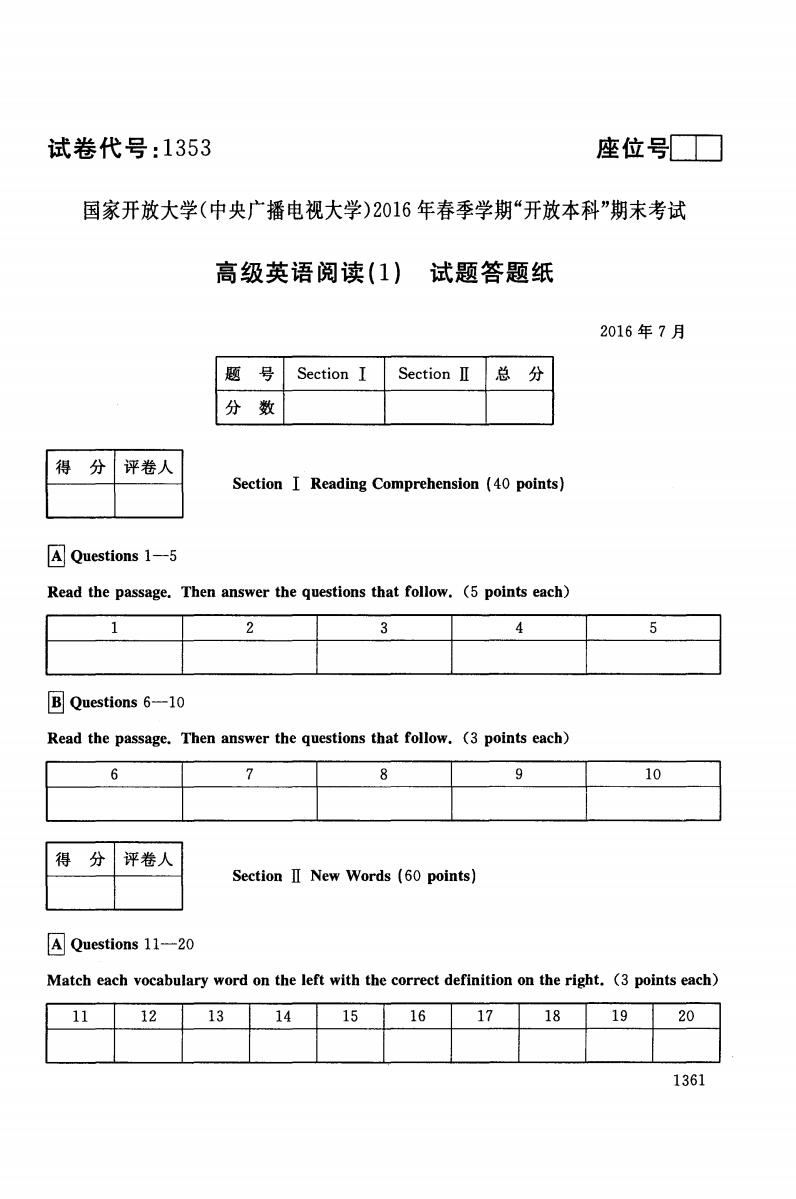
试卷代号:1353 座位号■■ 国家开放大学(中央广播电视大学)2016年春季学期“开放本科”期末考试 高级英语阅读(1)试题答题纸 2016年7月 题号 Section I SectionⅡ 总分 分数 得分 评卷人 Section I Reading Comprehension (40 points) A Questions 1-5 Read the passage.Then answer the questions that follow.(5 points each) 1 2 3 4 5 B Questions 6-10 Read the passage.Then answer the questions that follow.(3 points each) 6 7 8 9 10 得 分 评卷人 Section II New Words (60 points) A Questions 11-20 Match each vocabulary word on the left with the correct definition on the right.(3 points each) 11 12 13 14 15 16 17 18 19 20 1361
试卷代号 :1353 座位号 国家开放大学(中央广播电视大学)2016 年春季学期"开放本科"期末考试 高级英语阅读( 1 ) 试题答题纸 2016 Section 1 I Section 11 |得分|评卷人| | Section 1 Reading Comprehension (40 points) Ques 1S 1-5 Read the passage. Then answer the questions that foIlow. (5 points each) 1 2 3 4 5 Questions 6-10 Read the passage. Then answer the questions that foIlow. (3 points each) || |得分|评卷人| | 7 8 9 10 Section 11 New Words (60 points) Questions 11-20 Match each vocabulary word on the left with the correct definition on the right. (3 points each) 11 12 13 14 15 16 17 18 19 20 1361
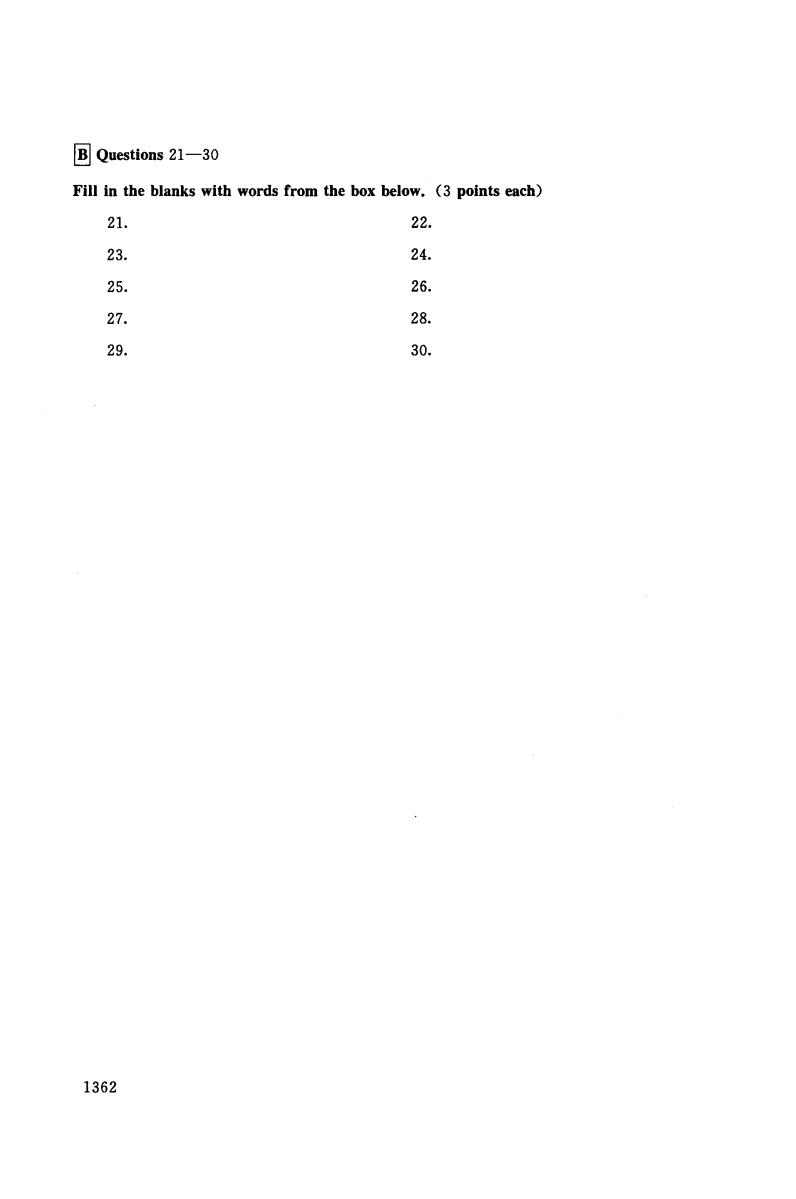
回Questions21-30 Fill in the blanks with words from the box below.(3 points each) 21. 22. 23. 24. 25. 26. 27. 28. 29. 30. 1362
Ques 21-30 FiII 10 the blaoks with words from the box below. (3 poiots each) 21. 22. 23. 24. 25. 27. 29. 1362 26. 28. 30
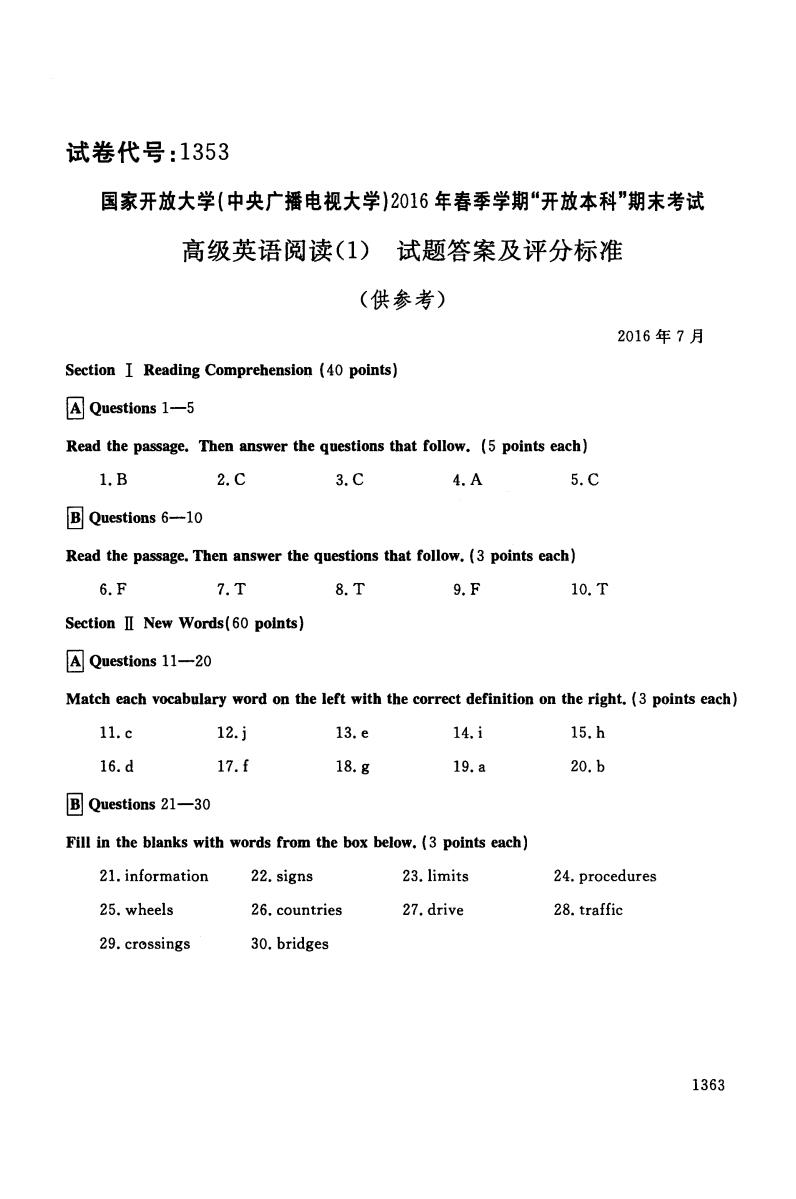
试卷代号:1353 国家开放大学(中央广播电视大学)2016年春季学期“开放本科”期末考试 高级英语阅读(1)试题答案及评分标准 (供参考) 2016年7月 Section I Reading Comprehension (40 points) ☒Questions1-5 Read the passage.Then answer the questions that follow.(5 points each) 1.B 2.C 3.C 4.A 5.C B Questions 6-10 Read the passage.Then answer the questions that follow.(3 points each) 6.F 7.T 8.T 9.F 10.T Section II New Words(60 points) ☒Questions11一20 Match each vocabulary word on the left with the correct definition on the right.(3 points each) 11.c 12.j 13.e 14.i 15.h 16.d 17.f 18.g 19.a 20.b 回Questions21-30 Fill in the blanks with words from the box below.(3 points each) 21.information 22.signs 23.limits 24.procedures 25.wheels 26.countries 27.drive 28.traffic 29.crossings 30.bridges 1363
试卷代号 :1353 国家开放大学(中央广播电视大学 )2016 年春季学期"开放本科"期末考试 高级英语阅读 (1) 试题答案及评分标准 〈供参考) 2016 Section 1 Reading Comprehension (40 points) Qu tions Read the passage. Then answer the questions that Collow. (5 points each) 1. B 2. C 3. C 4. A 5. C Questions 10 Read the passage. Then answer the questions that Collow. (3 points each) 队. F 7. T 8. T .F 10. T tion n New Wor (60 points) Qωu 1S 11 20 Match each vocabulary word on the leCt with the correct definition on the right. (3 points each) l 1. c 12.j 13.e 14.i 15.h 16.d 17.f 18.g 19.a 20. b Ques 1S 21-30 Fill in the blanks with words Crom the box below. (3 points each) 21. information 25. wheels 29. crøssings 22. signs 26. countries 30. bridges 23.limits 27. drive 24. procedures 28. traffic 1363